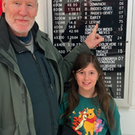A kid with a Cub
To the Editor:
Ask any pilot if he remembers his first flying lesson and the airplane in which this occurred. No doubt, and without hesitation, you will get a detailed and colorful description of this revered event.
As with many pilots, I started my flying career in a Piper J-3C Cub.
The Cub is about as basic an airplane as one can fly. There is a 65- horsepower, four-cylinder engine with a fixed pitch wooden propeller attached.
Located in front of the windshield is our gas gauge; a long metal rod, bent over the top to keep it from sliding down through the gas cap and inside the 12-gallon gas tank. The other end is attached to a shellac-covered cork that floats inside the tank.
The instrument panel is just as basic as the fuel gauge. Airspeed, altimeter, compass, oil temperature and pressure gauges, and inclinometer; all are accounted for.
Interior walls of fabric, basic stick and rudder, dual controls front and back. Windows of Plexiglas. A two-piece door, top and bottom, on the right side of the aircraft for entry and exit.
I am learning a new jargon: “throttle closed and cracked,” “brakes,” “contact.” Stan, my instructor, repeats the commands as another instructor hand props the Cub until the engine comes to life.
Because the Cub is a “taildragger” I learn to taxi in “S” fashion in order to see directly ahead of the airplane.
Cruising at 3,000 feet I am learning to coordinate the rudder and stick to bank and turn the airplane. Straight and level flight, climbing and gliding turns. I am devoting great energy and enthusiasm while performing my new tasks.
At the end of my second lesson, my instructor informs me that, in the next lesson, I will be introduced to stalls and spins. To the uninformed, these two words can sound a little intimidating. For me, this only drives my curiosity to learn more.
We practice power-on and power-off stalls. Full stalls, partial stalls, stalls straight ahead as well as in a turn. About half-way through the lesson, Stan introduces me to and performs the first spin.
The second spin is all mine. I initiate the stall, enter the spin, and recover after three turns. I do not have the finesse of my instructor, but I do this without any tutoring from Stan.
“Wow!” I exclaim. For me, this has got to be the greatest maneuver ever invented.
Successive lessons are spent learning to leave and return to the ground with some degree of precision and dignity, thus leaving the aircraft and its occupants in one piece.
My first attempt at landing resembles more of a controlled crash than a well-executed landing. Stan turns to me as he pushes his glasses back on his nose and motions me to try that again. Practice continues and my performance improves.
It is Sept. 20, 1959, when Stan pulls the airplane over to one side, exits the front seat and informs me that I am to make a take-off and landing and return the airplane to where he is standing. Today I make my first solo.
This is the greatest adventure that a 16-year-old could ever experience.
The first solo is only the beginning. It is on a bright sunny day when I arrive at the airport. I am now 21, and a new CFI [chief flying instructor].
I am assigned to a new student who has just started flying lessons. I prop N92635 and climb into the front seat. I am about to give my very first lesson in the same airplane that I received mine.
Later years find me as a chief flight instructor for an FAA [Federal Aviation Administration] flight school offering curriculums from private pilot up to and including airline transport pilot.
I am also chief pilot for a Part 135 operation for single- and multi-engine aircraft. This later leads to a corporate chief pilot’s position flying a Commander 690B and Learjet 24F.
I am now retired. Every once in a while, I ponder my logbooks and reminisce about my life as a pilot. I have many fond memories. Unfortunately, time has a way of changing things and slipping away.
There is one thing that time, at least for me, will never change. I will always be a kid with a Cub.
E.A. Chevrette Jr.
Guilderland
Editor’s note: E.A. Chevrette Jr. is the author of the book, “Wings of Fortune: Personal Tales from the ‘Golden Age of General Aviation.’”

